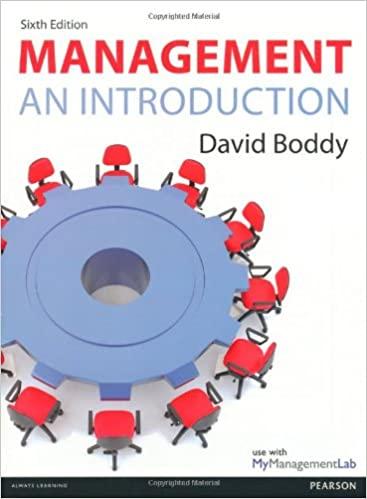Question
1. Which of the following is not one of The Ten Critical Decisions of Operations Management? A) layout strategy B) maintenance C) process and capacity
1. Which of the following is not one of The Ten Critical Decisions of Operations Management?
A) layout strategy
B) maintenance
C) process and capacity design
D) mass customization
E) supply-chain management
2. Productivity can be improved by
A) increasing inputs while holding outputs steady.
B) decreasing outputs while holding inputs steady.
C) increasing inputs and outputs in the same proportion.
D) decreasing inputs while holding outputs steady.
E) there is no way to improve productivity.
3. Among the ethical and social challenges facing operations managers are
A) honoring financial commitments.
B) maintaining a sustainable environment.
C) developing low-cost products.
D) providing an efficient workplace.
E) all of the above.
4. Which of the following is a reason for globalizing operations?
A) reduce costs with a reduction in effectiveness of the supply chain
B) improve the supply chain while increasing overall costs
C) understand markets
D) reduce stockholder approval ratings
E) increase costs at the risk of stockholder approval ratings
5. The fundamental purpose of an organization's mission statement is to
A) good human relations climate in the organization.
B) define the organization's purpose in society.
C) define the operational structure of the organization.
D) generate good public relations for the organization.
E) define the functional areas required by the organization.
6. Which of the following is an example of competing on the basis of differentiation?
A) A firm manufactures its product with less raw material waste than its competitors do.
B) A firm's products are introduced into the market faster than its competitors' products are.
C) A firm's distribution network routinely delivers its product on time.
D) A firm offers more reliable products than its competitors do.
E) A firm advertises more than its competitors do.
7. A simple CPM network has five activities, A, B, C, D, and E. A is an immediate predecessor of C and of D. B is also an immediate predecessor of C and of D. C and D are both immediate predecessors of E.
A) There are two paths in this network.
B) There are four paths in this network.
C) There are five paths in this network.
D) There are 25 paths through this network.
E) There is no critical path in this network.
8. The project organization works best when which of the following conditions are satisfied?
A) Work can be defined with a specific goal and deadline.
B) The job is typical and familiar to the existing organization.
C) The work contains simple tasks requiring no special skills.
D) The project is temporary but unimportant to long-term organizational success.
E) The project is confined to one functional area.
9. The main difference between PERT and CPM is that
A) PERT is more accurate than CPM.
B) PERT assumes that activity durations are known.
C) PERT ignores activity costs.
D) CPM assumes that activity durations can vary.
E) they differ in terminology and in the construction of the network.
10. Forecasts
A) become more accurate with longer time horizons.
B) are rarely perfect.
C) are more accurate for individual items than for groups of items.
D) are more accurate for new products than for existing products.
E) are impossible to make.
Step by Step Solution
There are 3 Steps involved in it
Step: 1

Get Instant Access to Expert-Tailored Solutions
See step-by-step solutions with expert insights and AI powered tools for academic success
Step: 2

Step: 3

Ace Your Homework with AI
Get the answers you need in no time with our AI-driven, step-by-step assistance
Get Started


